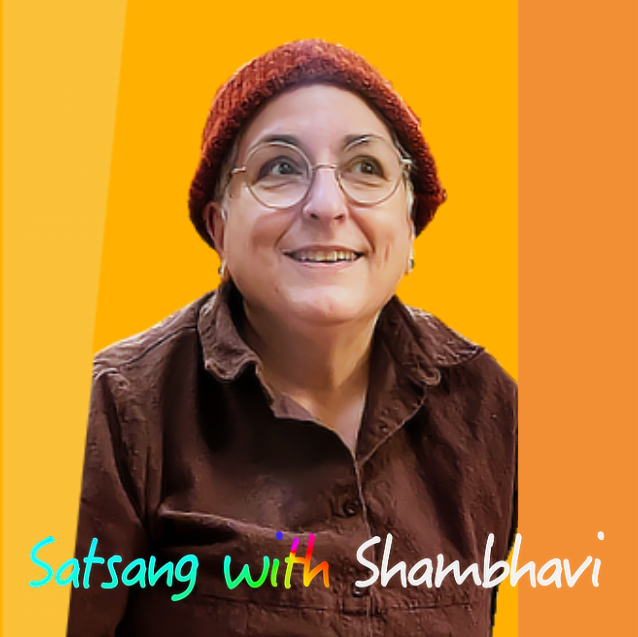Shambhavi lays out the Views of three different traditions and talks about the esoteric and ordinary histories of Trika Shaivism. A podcast from Satsang with Shambhavi
SHAMBHAVI
So I wanted to just give a very, very brief—I don't know if this is a teaching or a provocation or what it is. So you can take it any way you want. It's about the nature of God and what is the cause of events. The cause of things in our lives according to different kinds of traditions.
It's a way of getting a little bit of more clarity about where you actually are when you're practicing in a tradition like Trika Shaivism.
So when we're talking about the Abrahamic traditions, Islam and Judaism and Christianity mainly, when we're talking about a God who has sovereign power. One God, monotheism, who has sovereign power to make things happen or not happen. And who has sovereign power of reward and punishment.
When we're talking about almost all Buddhist traditions—and I wouldn't include Dzogchen in this, although it's only nominally Buddhist. When we're talking about all Buddhist traditions, we're talking about traditions that have gods that are considered to be forms of wisdom that help us in our practice.
But there is no overarching deity that's in control of things. And instead, everything is caused by our actions. Cause and effect, right? Karma. Cause and effect. So there's nobody in control, but there are laws. There are rules to how things operate.
If we're talking about Trika Shaivism, we're talking about there is one subjectivity in all of existence. That subjectivity gives rise to infinite numbers of forms of self-expression. Included among these are deities and humans and animals and things like that.
But everything is basically an aspect, an expression, of this one subjectivity. And that subjectivity has what is called svatantrya, total freedom of self-expression. And there are no rules of cause and effect.
As it's put, this subjectivity is in a state of total improvisation and has complete freedom in how it expresses itself. So cause and effect in Trika Shaivism is said to be a relative teaching.
In other words, it doesn't apply to the absolute. It is just something we experience in a limited form from our dualistic perspective. And as Anandamayi Ma said and Abhinavagupta also said, God makes the impossible possible, but also can make the possible impossible.
So basically anything could happen at any moment. And that's why [laughs]—so we're going from sovereignty, total sovereignty. And then based on reward and punishment, largely and from our perspective. To laws of cause and effect.
To totally spontaneous improvisation that's going on in all of existence. Where what is impossible could be possible or what is possible could become impossible.
So I wanted to sort of chunk out those three different perspectives on how things are happening according to each of those big swaths of traditions. So you can know a little bit more of what universe you're in.
STUDENT 1
Just to clarify, so you're saying Is Dzogchen kind of in that middle path you were talking about?
SHAMBHAVI
No. Dzogchen is—karma is also a relative teaching in Dzogchen. And although they don't talk about the nature of reality in exactly the same way as it's talked about in Trika Shaivism. There is ultimately no restriction on how this reality expresses itself.
How it's talked about in Dzogchen is that it's more animist, more influenced by Bon, and using more of a language of animism than of one subjectivity. But it's the same thing.
What is said by my teacher is that there is an infinite reservoir of potential expressivity, an infinite reservoir. So anything could be expressed. There's no restriction as to what could be expressed.
STUDENT 2
You describe those three things and kind of laid out a framework in a way.
SHAMBHAVI
Well, because I feel that we have a lot of people around now who haven't been around for that long. And it's hard to get a comprehensive view of what's happening if your main contact is online.
And then if you don't have a comprehensive view, you haven't met other people in the community. Or you're not hanging out with us in the same way that for many, many, many years we've been hanging out with each other.
And having those kind of side conversations and telling each other suggestions of things to read. And participating in a very more multifaceted way than just tuning into satsang once a week or twice a week, and occasionally coming to a teaching.
I mean, you have to know what universe you're in. Otherwise you start filling it in with a bunch of other stuff from other places. And you get a very warped, synthetic kind of idea of things.
And what I found is, even with the people that have been around for years sometimes and been to many teachings and been practicing. The tendency to just fill stuff in with our Abrahamic coalition tradition backgrounds is really powerful.
And so I feel like I need, especially in this online format, I need to make more effort to make sure that people clearly understand what they're stepping into here, right? And then get a better idea of whether it's for them.
And then for the people who have been around for a while. Some of you, not everyone, but some of you are quite lazy about really making the teachings your own.
And I'm surprised sometimes at the very basic questions I'll throw out that people can't answer. Even if you've been around for seven, eight, nine, or ten years.
So I'm asking people to sharpen your pencils a little bit and try to have a clearer understanding. Because then your practice can bear more fruit, if you have more clear understanding of the view. And what context you're actually practicing in.
STUDENT 3
You shared both that there's an infinite expressive possibility here, and then also that we are sort of located in one of the three. I'm interested maybe in what you're saying about what universe we are in and what that means. That in the context of the Self that has infinite expressive potential, there could be multiple different universes of causality that would be coexisting.
SHAMBHAVI
The thing that would be said and has been said, especially by Anandamayi Ma, my Satguru, is that all spiritual paths are a product of this one subjectivity. Even though we say this is—I want you to know what universe you're in. I don't mean literally a different universe.
I meant universe of View, what View we're in. But according to this View, all traditions, even the Abrahamic traditions and the cults and all of them are all being produced as a self-expression of this one subjectivity. And they're all for somebody. But yes, and also multiple universes.
STUDENT 3
A question that I had—kind of wondering about. The standing of View teachings in a tradition that at the end of the day, there's sort of no hierarchy of View teachings across the board.
And I guess i'm sort of trying to understand how View teachings come to be as they are. In what way are these View teachings informed by the specific geographic and temporal context? In what way might these View teachings differ if that part of the world had experienced a very different history?
So the example that I come back to—the Transatlantic slave trade. And just the scale of devastation there, that I don't think is of a kind of anything that the originators of this tradition experienced.
SHAMBHAVI
First question was about, for a tradition that teaches that there's infinite potentiality of expression, what is the status of View teachings? The status of View teachings is that they are functional for people who have not yet realized fully.
And in this tradition and in Dzogchen and in some other traditions from Tibet, but not all of them, the ultimate teaching is hold no View. However, I don't say this very often because then it gives certain swaths of people who leave to be extremely lazy in learning the View teachings. [Laughs]
But the ultimate teaching is hold no View. Just be in the freshness and the immediacy of experience and deal with it. Don't have a View. At the end of the day, View is in the way.
But in the beginning and middle of the day, View is very useful to orient you and orient you to practice. So it's a temporary device.
Where View comes from, where the teachings come from, has two different histories. One of which cannot be really fully known. So one history has to do with the hierarchy of beings that transmit teachings into the human realm.
And the practitioners who realize those teachings and the View and their own embodied experience, through doing sadhana. That history can't be told in a normal way.
Like as a historian at the university would tell it. With documentation, and facts and figures and all that, artifacts. But it can be told in the history of every single sincere practitioner.
Because that same process of receiving and embodying happens in every practitioner. And so the whole history of how the teachings come to be and come to be realized, is realized in the course of practice. In an experiential way. Again, it's not told in the same way that is documented by an ordinary historian.
But that same process, even depending on where you're at in your life cycle and span and lifetime cycle. Even the process of receiving teachings directly without any intercessor of a book or a human teacher, can also even happen to ordinary practitioners.
And so you come to understand the process by which living wisdom gives us symbols and techniques to practice with. So that we realize the nature of the teachings in ourselves. So that's one history of the teachings that is being recapitulated in every single practitioner to some degree or another.
The more ordinary history of the teachings, which has to do with your later question, is much harder to answer for a few different reasons. But sort of what if? I mean, really, I can't answer that kind of a question. I would be pulling the wool over your eyes if I even tried.
However, I don't know where you're getting your information that the kind of destruction that happened during the Atlantic slave trade never happened in the history of Tibet or India. I mean, I don't know if that's true or not.
I don't know how we would measure what would be commensurate. I just don't know if your first assumption is true or not. And maybe you have some information that I don't have. Maybe you've studied some histories that I haven't studied and you're speaking from some actual knowledge.
But I wouldn't make that assumption. In any case, I do know something, though from my own observation. And observation, I mean, my 30 years of study of this tradition and one or two other traditions. That traditions get more conservative over time.
So what I mean by that is they begin to absorb the more culturally-inflected ordinary-history-inflected prejudices of whatever culture they're situated in. Over time, the traditions themselves become more moralistic. They become more misogynistic. They become more racist over time.
Which is kind of bizarre because you have people practicing. You would think that, that wouldn't happen. But somehow it does. You know, at some point a tradition begins with, let's just hypothesize some more or less relatively open and pure transmission of wisdom.
And then human practitioners get a hold of it. And then you have popes and you have bishops and you have grand poobas proclaiming this and that. And trying to maintain their cultural, political, economic power. And all these things are going on.
So I can definitely trace this process in Trika Shaivism for sure, which is the tradition I've studied more. So I could say that about more ordinary histories. Included into that would be generational experiences of big events in the life of countries.
And how—you brought up the Atlantic slave trade—how those multigenerational events, or even just one-off events. Maybe not even multigenerational. Maybe a war that happened over a several year period. Those things could definitely inflect how a tradition, how it matures.
But I would say that the traditions that I have studied in, from my own perspective, have started with transmissions of wisdom into the body, minds, and hearts of practitioners from wisdom. From wisdom beings. From Dakinis.
There's also a very specific history of that around Tibet and Kashmir that Trika Shaivism and Dzogchen share, which is this esoteric landscape called Oddiyana.
Now, Oddyiana was possibly an actual physical place somewhere like around the Swat Valley, which used to be Kashmir and is now Pakistan. And which is the seat of some of the foundational traditions that went into Trika Shaivism and also Dzogchen. That same part of the world, at the same time.
And yet Oddiyana is also considered to be a wisdom realm. Like another universe that is somehow simultaneously existing with earthly realm, which is populated by wisdom teachers, Dakinis. And which is transmitting the teachings to specific human beings for dissemination among human practitioners.
And I've had a little bit of personal experience with that in my practice. Enough to feel that that's the real history of the traditions. And to feel less concerned about how the traditions are being inflected by culture and historical events and all that kind of a thing.
I find that somewhat interesting, but it's not that I don't want to talk about it. It's just not as interesting to me as the process of direct getting of wisdom is magical and fascinating. And I want more of it.
Certainly there has been a mini-genocide of Kashmiri Pandits. And how that's affected the tradition these days, I have no idea. I mean, that's much more recent history than the Atlantic slave trade. But certainly for that much, much smaller population of people, just as devastating.
One thing I have hypothesized is that at least in terms of Dzogchen, the enormous presence of the sky and Tibet. Of the open sky. How that has affected the transmission of the teachings, the view, and the actual practices that are done.
And I don't know. I've never been to Kashmir, unfortunately. Ever since I've been practicing, Kashmir has been in such political turmoil that it's just been too dangerous to take a group of students there. I just haven't wanted that responsibility.
I don't know how the sky is in Kashmir. But I know that just in my own life, having lived in a bunch of different places, that the balance of the elements where you live is hugely affecting, hugely.
And certainly the presence of air, space, and space element in Tibet, so ever present, and the relative emptiness of the landscape below the sky, I think has had a profound effect on people's minds.
Sign up to receive email updates
Enter your name and email address below and I'll send you periodic updates about the podcast.
Read More About Trika Shaivism & Dzogchen
Photo by Franky Ng


